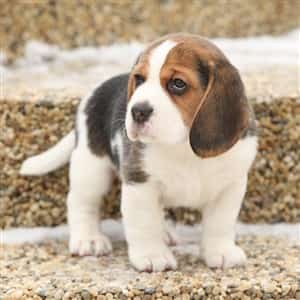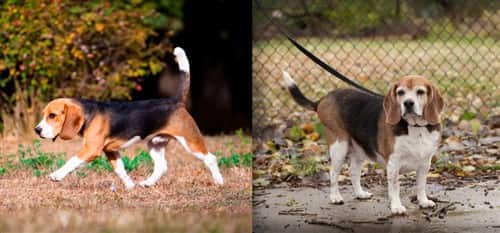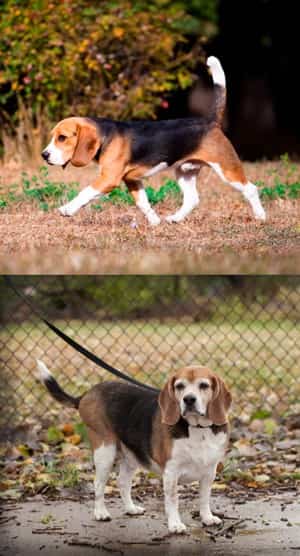How to Help a Beagle Lose Weight
Overview
If your Beagle is carrying too much fat, you’re not the only owner contending with this issue. This is not uncommon with adult Beagles, and risk of obesity increases as a Beagle heads towards his or her senior years.
Some owners are surprised when they realize that their Beagle is overweight. What was once a sleek profile is now thick and padded. Muscles are not as defined. What happened? Isn’t this a very active breed, always on the go? Shouldn’t food be easily burned off?
Well, that definitely holds true for the Beagle breed in general; however, the other part of the equation is that Beagles typically have very hearty appetites, and it’s really easy for there to be a surplus of calories that surpasses what is needed to fuel activity. And, just like with humans, those extra calories will be stored as fat.
Fortunately, there are some methods to help a Beagle lose weight that cause no physical stress or that leaves a Beagle super hungry. It’s all about putting focus on the right things, and going about this in an effective yet gradual way.
So, if your Beagle is a bit... Shall we say, rotund, chubby, or otherwise plump, let’s cover exactly what to do.
Please note:
BeaglePro is reader-supported, and some of the product suggestions on this page are affiliate links. As an Amazon Associate we earn from qualifying purchases. This is at no extra cost to you and helps us keep this site running.
A Word About Beagle Puppies
There is really no such thing as an overweight Beagle puppy. Puppies are supposed to carry extra fat, and look rather round. That extra layer of fat helps the pup maintain proper body temperature, and is needed to fuel a rapidly growing body.
Most Beagles are done growing by the 18-month mark. And it is by the 1.5 to 2-year mark that extra, unhealthy weight may then be piling on. As each year goes by, chances increase that a Beagle will be carrying excess weight.
How to Know if a Beagle is Overweight
With a breed like the Beagle that has such a large range of standard weight, it’s not always easy to tell by the scale. And, if you go by AKC standard weight guidelines, this does not tell the whole story.
For Beagles that are 13 inches (33 cm) or less (measured floor to withers, which are the top of the shoulder blades) AKC standard weight is ‘under 20 pounds’ (9.07 kg), and for Beagles with a height of 13 to 15 inches (33 to 38 cm), AKC standard weight is 20 to 30 pounds (9.07 to 13.6 kg).
However, there are lots of Beagles that are heavier than that maximum of 30 pounds, and this does not necessarily mean that they are carrying too much fat. They may be taller than the 15 inches, or may be a larger than average bone structure.
And, there are Beagles in the 20 to 25 pound range, that should be 15 or 17 pounds; thus while they may be smaller than some other Beagles, they are overweight.
So, due to both bone structure and height differences, it's wise to look beyond the scale.
The best way to know for sure, before you take any steps to help your Beagle drop a few pounds, is to have your dog examined by the veterinarian. There are other important reasons as well, since the vet can rule out health issues that can cause a dog to gain weight, as well as evaluate your dog’s ability to engage in some extra activity to burn calories.
This said, a check of your Beagle’s body shape and feeling for fatty areas can give you a basic idea of whether or not there is too much fat on the body. While other dogs need to be wet down to have a look at profiles, with such a short coat, this is not needed for Beagles.
1. Look at your Beagle from above.
Do you see a defined waist? There should be a narrowing of the body between the ribs and the hips.
2. Look at your Beagle from the side.
There should be an uptuck, where the abdomen tucks up into the rib cage.
3. Feel the base of your Beagle’s tail.
It should be smooth and you should be able to easily feel the base where it meets the spine.
4. Feel the rib cage.
You should be able to easily feel each defined rib without excess fat being in the way. Feeling ribs, but under some fat points to a weight issue. If you cannot feel the ribs at all, this points to a dog being severely obese.
As you can see in the photo below, the Beagle on the left is a healthy weight; and the Beagle to the right is overweight. If you are wondering if your Beagle is too fat, chances are that he/she falls somewhere between these two.
And, keep in mind that aging is not an excuse to carry excess pounds. It is normal for an older Beagle to have some muscle loss compared to his younger self; however, older adults and senior Beagles are not excused from being overweight; for older dogs, maintaining a good weight is more important than ever.
Health Conditions that Can Cause a Beagle to Be Overweight
There are a few health conditions
that can either cause weight gain, or cause fluid retention that appears to be weight gain. This includes:
Cushing’s disease
– Signs include increased hunger and/or thirst, panting, weight gain, fluid retention in the abdomen that causes a pot-bellied appearance, hair loss, and/or reoccurring infections including ear infections and UTIs.
Heart disease
– Signs include coughing, trouble breathing, fluid retention in the abdomen that causes a pot-bellied appearance, acting withdrawn, decreased appetite, weight loss or weight gain, lethargy, and/or restlessness (particularly at night).
Hypothyroidism
– Signs include lethargy, weakness, trouble focusing, weight gain, excessive shedding, hair loss, poor coat health, skin issues such as infections or scaling, and intolerance to cold.
If any of these conditions are suspected, it will be important to bring your Beagle to the veterinarian for a complete checkup.
Risks of Canine Obesity
There is a plethora is reasons to get your Beagle back to a healthy weight. In fact, his or her very life depends on it.
Obesity is linked to:
- Damage to internal organs
- Bone damage
- Joint damage (25% of overweight dogs develop serious joint complications)
- Decreased stamina which puts strain on the heart, muscles, and respiratory system
- Muscle loss
- Canine diabetes (overweight dogs are 2.6 times more likely to develop diabetes)
- Digestive disorders including upset stomach and flatulence
- Respiratory compromise (breathing difficulty)
- Heat intolerance
- Hypertension (high blood pressure)
- Liver disease
- Osteoarthritis
- Lowered immune system function
- Increased risk of developing some cancers (studies have shown a link between obesity and bladder cancer and mammary tumors)
- Shorter life span (studies suggest a 2-year shorter life span for overweight dogs)
How to Help a Beagle Lose Weight
If underlying health issues have been ruled out, and if the vet has confirmed that there are some excess pounds, it will be time to make some changes.
It’s a good idea to plan ahead, so that you will know what to expect, can set goals, and prepare to have the right things in place.
Here are the 6 steps for helping a Beagle reach a healthy weight:
1. Have the right mindset
Helping your dog lose weight should revolve around healthy lifestyle changes, and be an attainable challenge that you and your Beagle work on together. This should be a positive thing, and not something that you dread ‘putting your dog through’ or a situation in which you feel bad for your Beagle.
2. Have realistic goals
The goal should be a slow yet steady weight loss. Fast weight loss almost always involves a dog physically overextending himself, which is dangerous, and/or being in a severe calorie deficit which not only can make a Beagle weak or vulnerable to illness, but also lead to moodiness and behavioral changes.
Depending on how much weight your Beagle has to lose, a 1 to 2-pound loss each month is both achievable and feasible.
3. Double-check food and snack servings
Unless you’ve been pouring kibble into your Beagle’s bowl willy-nilly, or allowing your dog to fetch his own treats, chances are that there does not need to be any drastic changes in how much food your dog is given (see next point below regarding calories).
However, it’s always a good idea to take the time to read the feeding instructions on kibble (and yes, this will need to be changed to a low-calorie option, more ahead), to ensure that you are doling out a reasonable amount.
Though many owners assume that snacking must be reduced, treats can still be given up to 4 times per day while allowing a Beagle to lose weight. Giving out snacks helps curb a Beagle’s hunger until the next meal time, and importantly helps keep up moral. The key is to ensure that they are truly tasty but super-low calorie.
And as always, we recommend reserving treats as rewards for good behavior.
4. Make a switch to quality low calorie kibble AND snacks
It can be distressing for a dog to have a drastic decrease in the amount of food that he’s receiving. So, the best way to help a Beagle lose weight is to offer roughly the same amount of food, for both meals and treats, but have these be lower calorie options.
Choosing low calorie options:
You’ll need to be careful here, because it is still vital to ensure that what you give to your Beagle is still held to high standards. Meals and snacks should be 100% all natural, with no chemical preservatives or artificial flavoring. There should be no MSG, high grain content, corn, soy, fillers, or by-products. There should be no generic meats or oils, and it should be manufactured in the US.
When you look for diet food for your Beagle, you may see it labeled as ‘healthy weight’, ‘weight management’, ‘low calorie’, ‘reduced fat’, or other such terms.
However, what you’ll want to pay the most attention is that it is a superior, top-quality food that avoids all
the pitfalls (synthetic preservatives, fillers, high grain content, etc. as mentioned above) while offering great flavor in a reduced calorie, lower fat formula with slightly higher than average protein (which helps reduce hunger and boost metabolism), and slightly higher than average fiber (which helps reduce hunger).
Recommended diet kibble:
Our top recommended dog food to help Beagles lose weight in a healthy manner is Wellness CORE Natural Reduced Fat Grain-Free Dry . This is low calorie (360 calories per cup vs 421 in the regular formula), has 25% less fat, good protein levels (33% crude protein), and good fiber levels (8.5 vs 3 to 4% found in the regular formula).
. This is low calorie (360 calories per cup vs 421 in the regular formula), has 25% less fat, good protein levels (33% crude protein), and good fiber levels (8.5 vs 3 to 4% found in the regular formula).
As always, Core comes through with a superior kibble that has zero chemical preservatives, no artificial flavors, no grain, corn, soy, wheat, fillers, or by-products. And this is made in the USA.
Recommended low-calorie snacks:
If you want your Beagle to be able to munch away on snacks and still be rewarded for all sorts of good behavior, not to mention the benefits of offering something to tide a dog over in between meals, there are a couple of great options.
One is Old Mother Hubbard's Low Fat Crunchy Natural Dog Treats ; these are oven baked, each treat is a blend of chicken, oatmeal, apple, and carrot, and there are 21 calories per treat. As always, there is no chemical preservatives, artificial flavoring, by-products, corn, soy, or wheat. These are made in Canada.
; these are oven baked, each treat is a blend of chicken, oatmeal, apple, and carrot, and there are 21 calories per treat. As always, there is no chemical preservatives, artificial flavoring, by-products, corn, soy, or wheat. These are made in Canada.
Another great option is Zuke's Skinny Bakes Dog Treats . These come in 3 different tasty flavors: cherries & berries, peanut butter & bananas, and pumpkin & sweet potato. There are just 10 calories per treat. And as with the other Zuke's treats, there is no wheat, corn, or soy, and these are made in the USA.
. These come in 3 different tasty flavors: cherries & berries, peanut butter & bananas, and pumpkin & sweet potato. There are just 10 calories per treat. And as with the other Zuke's treats, there is no wheat, corn, or soy, and these are made in the USA.
Hopefully, you are giving your Beagle a daily dental treat to keep his teeth clean and free of decay; and you should continue to do this while your Beagle is on a diet.
Greenie’s offers a low-calorie option with their GREENIES Weight Management Dental Treats , which has just slightly less calories (88 per treat vs 90), slightly less fat (min. 5% vs 5.5), but has more fiber 10% vs 6 %, and contains L-carnitine, which helps boost the metabolism.
, which has just slightly less calories (88 per treat vs 90), slightly less fat (min. 5% vs 5.5), but has more fiber 10% vs 6 %, and contains L-carnitine, which helps boost the metabolism.
5. Encourage Slow Eating
If your Beagle essentially inhales his meals, he may be begging for more food before you can blink your eyes. But, when a dog has to take his time to eat, it’ll allow his stomach and brain to recognize that the food is being received. Not to mention that rapid ingestion of food is a leading cause of killer bloat and should be avoided at any rate.
Some methods to encourage slow eating are:
1 – With a slow-feeding bowl. The idea behind these is to displace food, as opposed to having it all in one pile and able to be quickly ingested.
You’ll want to steer clear of plastic bowls, and there are a lot of them on the market, in all sorts of designs and shapes that look really cool. But, even plastic that is labeled BPA or PVC free can cause allergic reaction, not to mention that these typically slide around all over the place.
So, look for a solid, heavy, stainless-steel slow feeding bowl like the DuraPet Slow Feed Premium Stainless Steel Dog Bowl .
.
2 – With a portion pacer.
These are stainless-steel or porcelain balls that are placed into existing bowls, with the idea that a dog will need to eat around the ball (they’ll nose it along as they eat). These do not work as good as the slow-feeder bowls, and some Beagles quickly learn to move the ball onto the floor, but is worth a shot if you or your Beagle is attached to a favorite dish and you do not want to change it.
3 – Treat dispensing toys.
Not all meals need to be served in a bowl, and particularly if your Beagle is home alone
during meal time, this can be a great option. These are designed to release food slowly, and can keep a dog busy for up to an hour, playing with the toy to receive his kibble.
A good one to try is the StarMark Bob-A-Lot Treat Dispenser . It's large enough to fit an entire meal, unlike others that are just meant for snacks, and it keeps a dog engaged due to its wobbling motion.
. It's large enough to fit an entire meal, unlike others that are just meant for snacks, and it keeps a dog engaged due to its wobbling motion.
6. Increased Activity
Along with reduced calorie intake, increasing activity is an important part of helping a Beagle lose weight. If this is not incorporated into a weight loss plan, it will take much longer to see any progress.
In addition, regular exercise is vital for good health, and can increase life span. So, whether your Beagle is already rather active, or has been sedentary far too long, now is the time to get things moving along a bit more.
- If your Beagle is very overweight, check with the veterinarian to design a plan that will not cause overexertion or risk of injury.
- With all Beagles, you’ll want to carefully monitor things to ensure that your dog is drinking lots of water while exercising, and does not overheat while running around.
You’ll want your Beagle to build up exercise endurance, so it’s a good idea to start with adding on 10 minutes to each daily walk. As the days and weeks follow, make things gradually more challenging and fun. Walk up hills. Head out on a hiking trail. Take a walk along the beach.
In addition, there’s calories to be burned right in your yard. Grab a fun toss toy like the KONG Wubba Toy
 (it has two different balls - a tennis ball and a squeaker ball, wrapped in durable fabric with trailing tails), and play a rousing game of fetch. Remember that the more you show enthusiasm, the more your Beagle will be engaged in the game. After just a few fun sessions, your Beagle may be the one leading you outside instead of vice versa.
(it has two different balls - a tennis ball and a squeaker ball, wrapped in durable fabric with trailing tails), and play a rousing game of fetch. Remember that the more you show enthusiasm, the more your Beagle will be engaged in the game. After just a few fun sessions, your Beagle may be the one leading you outside instead of vice versa.
As your Beagle drops some weight, and muscles start to build up, you’ll be able to add on 15 and then even 20 minutes to each outing (be sure to offer breaks and water). And, work your way up to adding on an extra session of exercise each day. Taking a Beagle out for walks or play 3 or even 4 times per day is healthy for both of you as long as the buildup to this level of activity is done slowly and gradually.
Other Helpful Articles:
Beagle Car Sickness
- If your Beagle's motion sickness takes the fun out of bringing your dog to different places, see how you can greatly reduce this common issue and make car rides a breeze.
Taking Care of a Beagle's Teeth
- If you ignore dental care, you'll probably regret it. Canines can suffer from terrible tooth decay.
Can a Beagle Live Outside
- Chances are that your Beagle loves to be outdoors, but would your dog be okay actually living outside?




